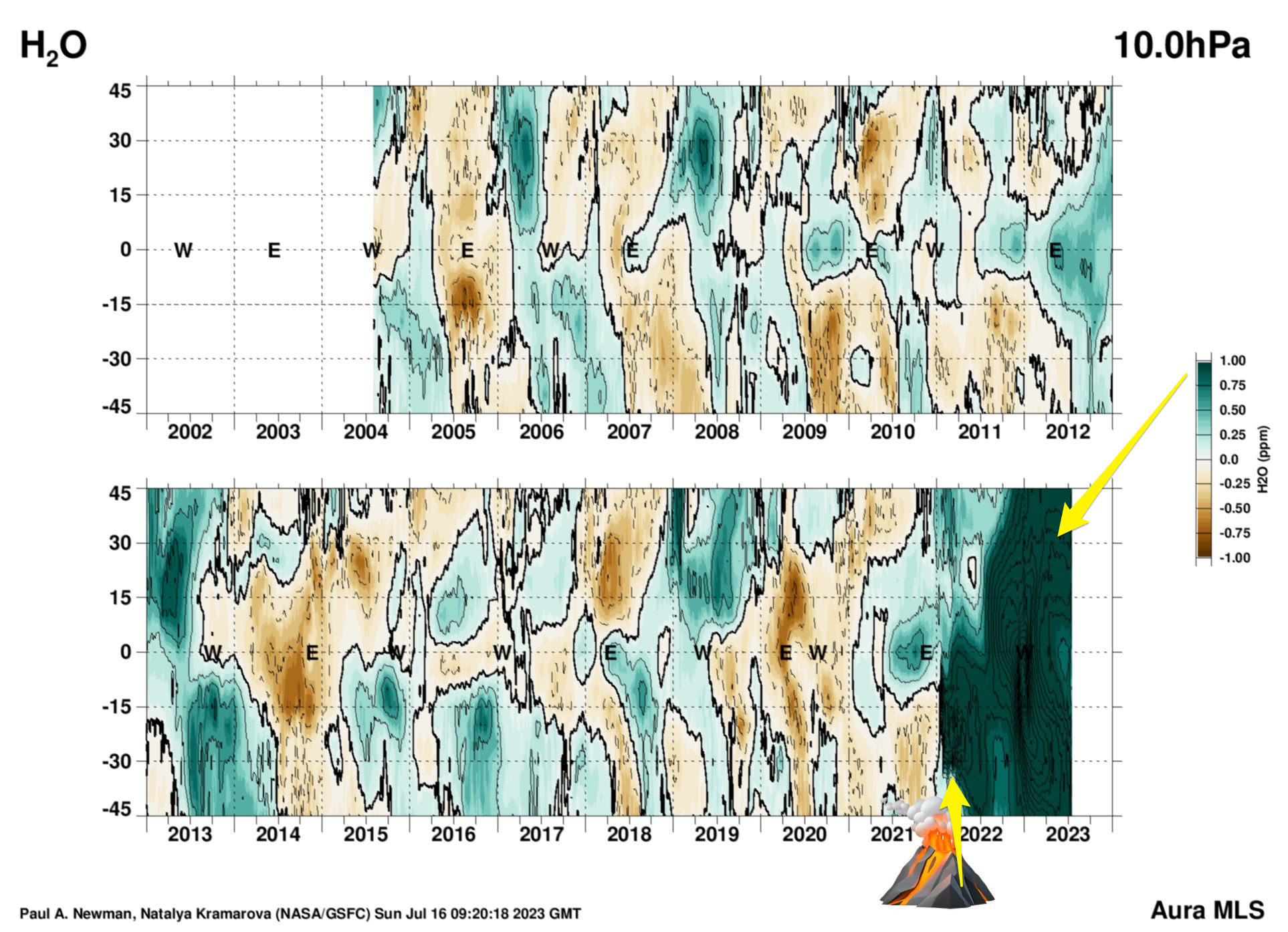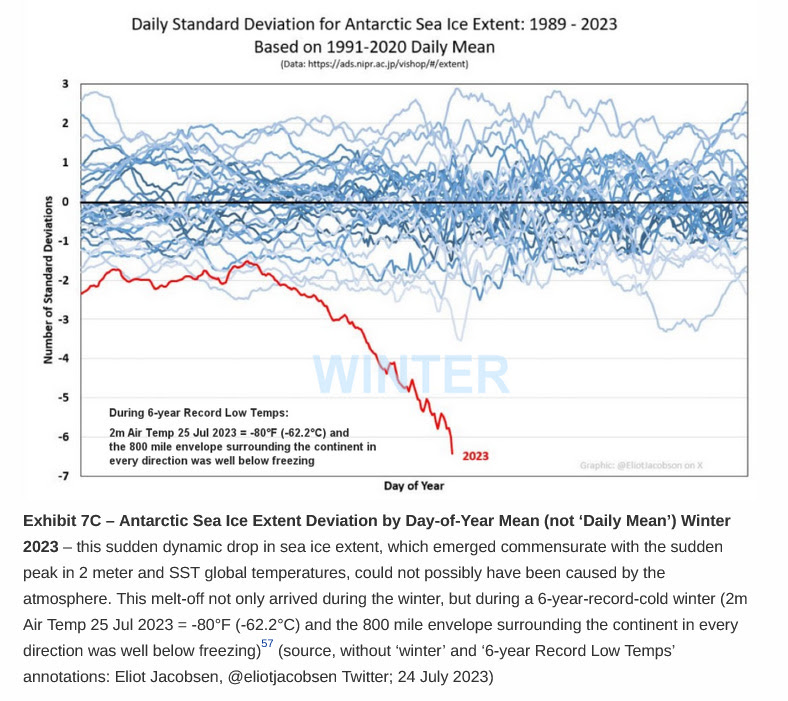…
Ready to learn something? Let’s meet the historic, record-shattering Hunga Tonga volcanic eruption of 2022, which I bet you never heard of. Back in January 2022, you were probably distracted by covid mandates or maybe by Biden calling himself “Senator” again. The short version is an underwater Pacific Ocean volcano named Hunga Tonga-Hunga Ha’apai, 490 feet under the waves, massively erupted, bigger than any other modern eruption, even bigger than Mount Pinatubo.
You never heard about it since it was underwater and nobody died. But the erupting lava instantly vaporized fantastic, unimaginable amounts of sea water, which billowed into the atmosphere, changing the water composition of Earth’s atmosphere and heating it up for years. In only a few days, the superheated water from the Hunga Tonga eruption blanketed the globe, pole to pole, East to West.
The eruption was so big it could be clearly seen from space.
Here’s an August 2022 headline about the eruption, straight from the NASA website:
“Unprecedented” is accurate but doesn’t do it justice. Here’s how the rocket-slash-climate experts at NASA described Hunga Tonda as one of the most dramatic events in modern history:
When the Hunga Tonga-Hunga Ha’apai volcano erupted on Jan. 15, it sent a tsunami racing around the world and set off a sonic boom that circled the globe twice. The underwater eruption in the South Pacific Ocean also blasted an enormous plume of water vapor into Earth’s stratosphere – enough to fill more than 58,000 Olympic-size swimming pools. The sheer amount of water vapor could be enough to temporarily affect Earth’s global average temperature.
The not only injected ash into the stratosphere but also large amounts of water vapor, breaking all records for direct injection of water vapor, by a volcano or otherwise, in the satellite era. …The excess water vapor injected by the Tonga volcano … could remain in the stratosphere for several years. This extra water vapor could influence atmospheric chemistry, boosting certain chemical reactions that could temporarily worsen depletion of the ozone layer. It could also influence surface temperatures … since water vapor traps heat.
“We’ve never seen anything like it,” said Luis Millán, an atmospheric scientist at NASA’s Jet Propulsion Laboratory in Southern California.
Over the next year it would turn out that NASA badly underestimated the amount of water Hunga Tonga vaporized into the atmosphere. Current estimates are three times higher than the original: scientists now think it was closer to 150,000 metric tons, or 40 trillion gallons, of super-heated water instantly injected into the atmosphere. Talk about a greenhouse. Water vapor — humidity — is a much more effective greenhouse gas than carbon dioxide.
A new study published in April this year analyzed the 1-year aftereffects:
With a year’s hindsight, the 2023 researchers also concluded that Hunga Tonga was one of the most remarkable climate events in modern history, and its effects are expected to last for years:
[D]ue to extreme altitude reach of the eruption, volcanic plume circumnavigated the Earth in only one week and dispersed nearly pole-to-pole in three months. The observations provide evidence for an unprecedented increase in the global stratospheric water mass by 13% as compared to climatological levels. As there are no efficient sinks of water vapour in the stratosphere, this perturbation is expected to persist several years. The eruption has also led to a 5-fold increase in the stratospheric aerosol load, the highest in the last three decades yet factor of 6 smaller than the previous major eruption of Mt Pinatubo in 1991.
The unique nature and magnitude of the global stratospheric perturbation by the Hung eruption ranks it among the most remarkable climatic events in the modern observation era.
But I bet you never heard anything about Hunga Tonga, did you? Thanks, media. Better late than never, though. And if I’m doing my job right, you’re starting to think, hey, maybe the hot summer weather this year might have something to do with this historic volcanic eruption last year? If so, you aren’t the only one. Here’s another study, from April this year:
Say hello to the “global warming” plume most completely ignored by corporate media. These researchers were even more direct in connecting the “historic heat wave” to Hunga Tonga:
We find that the Hunga Tonga-Hunga Ha’apai eruption produced the … largest perturbation of stratospheric water vapour observed in the satellite era. … fter two weeks, due to dilution, water vapour heating started to dominate the top-of-the-atmosphere radiative forcing, leading to a net warming of the climate system… This is the first time a warming effect on the climate system has been linked to volcanic eruptions, which usually produce a transient cooling.
The story made the science news, which makes it even more surprising that corporate media somehow found a way to successfully ignore the story. Here’s an EOS headline from March of this year:
See that? Hunga Tonga warming could last five more years. At this rate, the plume will likely outlive Joe Biden.
Corporate media isn’t ignoring the story because it lacks for dramatic graphs and charts. Here’s a chart I found showing how atmospheric water vapor increased recently compared to the prior twenty years. The atmosphere’s water concentration is off the chart:
See that? For the first time since tracking began, the amount of water vapor in the atmosphere is pegged out at the maximum, across the board.
Here’s why corporate media is ignoring the most dramatic climate even in modern history: because you can’t legislate underwater volcanoes. You can try, but they won’t listen. So what’s the fun in that? Corporate media only exists to further political ends. Since volcanoes aren’t subject to politics, why bother?
… click HERE to read the rest, including this astonishing chart (keep in mind it is the middle of winter in Antarctica right now):











